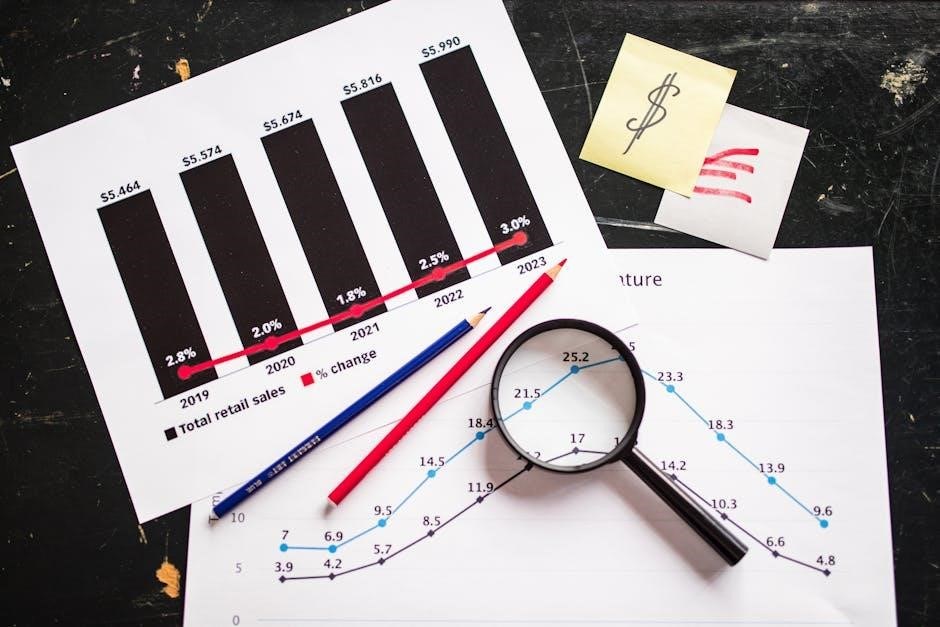A temperature conversion chart is an essential tool for quickly switching between Celsius and Fahrenheit scales. It provides a clear, organized way to convert temperatures, making it ideal for everyday use in cooking, science, and weather forecasting. The chart typically includes a range of temperatures, often from -40°C to 225°C, in easy-to-read increments. Its PDF format allows for easy printing or digital use, ensuring convenience and accessibility for various applications.
Overview of Celsius and Fahrenheit Scales
The Celsius and Fahrenheit scales are the two most commonly used temperature measurement systems worldwide. The Celsius scale, created by Anders Celsius, is based on the freezing and boiling points of water, with 0°C and 100°C respectively; The Fahrenheit scale, developed by Gabriel Fahrenheit, uses 32°F for water freezing and 212°F for boiling. While Celsius is widely used in scientific and international contexts, Fahrenheit remains prevalent in the United States. Both scales are essential for everyday applications, from cooking to weather forecasting, and their conversion is often necessary for global communication and understanding.
Importance of Conversion Charts in Daily Life
Conversion charts are invaluable in daily life, simplifying tasks that require temperature unit changes. They are particularly useful in cooking, where recipe temperatures often differ between countries. For instance, converting Celsius to Fahrenheit ensures accurate baking and roasting. In scientific settings, precise temperature conversions are crucial for experiments and data analysis. Weather forecasting also relies on these charts to communicate temperatures to international audiences. Having a quick reference chart saves time and reduces errors, making it an essential tool for professionals and home users alike. A PDF chart is especially convenient, as it can be easily accessed digitally or printed for offline use.
Why Use a Centigrade to Fahrenheit Chart in PDF Format
A Centigrade to Fahrenheit chart in PDF format offers unparalleled convenience and accessibility. The PDF format ensures that the chart remains consistent across devices, whether viewed on a computer, smartphone, or printed. It eliminates the need for internet access, making it ideal for offline use. PDF charts are also easy to share and can be stored locally for quick reference. The ability to print the chart allows for physical use, such as posting it in a kitchen or laboratory. Additionally, PDFs are universally compatible, ensuring that anyone can access the chart without special software, making it a practical choice for everyday use.

Understanding the Conversion Process
The conversion process involves mathematical formulas to switch between Celsius and Fahrenheit. Using charts simplifies this process, providing quick references for precise temperature conversions without calculations.
Formulas for Converting Celsius to Fahrenheit
The formula to convert Celsius to Fahrenheit is: F = (C × 9/5) + 32. This equation allows precise conversion by multiplying the Celsius temperature by 9/5 and then adding 32. For example, to convert 40°C to Fahrenheit, calculate (40 × 9/5) + 32 = 104°F. This formula is widely used in scientific and everyday applications. It ensures accuracy for all temperature ranges, from freezing to boiling points. Using this formula, anyone can easily convert Celsius to Fahrenheit without relying on charts or converters, making it a fundamental tool in temperature conversion.
Formulas for Converting Fahrenheit to Celsius
The formula to convert Fahrenheit to Celsius is: C = (F, 32) × 5/9. This equation reverses the Celsius to Fahrenheit conversion by first subtracting 32 from the Fahrenheit temperature and then multiplying by 5/9. For example, to convert 104°F to Celsius, calculate (104 ⎻ 32) × 5/9 = 40°C. This formula is essential for precise temperature conversions, especially in scientific and culinary applications. It ensures accuracy when working with Fahrenheit temperatures, making it a vital tool for anyone needing to convert temperatures between the two scales.
Step-by-Step Guide to Using the Conversion Chart
Using a Celsius to Fahrenheit conversion chart is straightforward. First, identify the temperature in Celsius from the left column. Locate the corresponding Fahrenheit temperature in the right column. For example, if you need to convert 30°C, find it on the Celsius side and read the matching Fahrenheit value, which is 86°F. Ensure the chart includes the temperature range you need, such as -40°C to 225°C. This method saves time and eliminates the need for manual calculations. It’s ideal for quick reference in cooking, science, or weather applications, providing accurate and efficient conversions.

Structure of a Centigrade to Fahrenheit Chart
A Centigrade to Fahrenheit chart typically features two columns, listing Celsius temperatures alongside their Fahrenheit equivalents. It covers a wide range of temperatures, often in 5°C increments, from -40°C to 225°C, ensuring comprehensive coverage for various applications. The chart is designed to be print-friendly and easily navigable, with clear numbering and spacing to facilitate quick conversions.
Key Features of an Effective Conversion Chart
An effective Centigrade to Fahrenheit conversion chart should prioritize clarity and legibility. It typically includes side-by-side columns for Celsius and Fahrenheit temperatures, allowing for quick comparisons. Color coding or visual hierarchies can enhance readability, while a clean, uncluttered design ensures ease of use. The chart should cover a wide temperature range, often from -40°C to 225°C, in 5°C increments, making it versatile for various applications. A print-friendly format is essential, with options for digital use. Interactive elements in digital versions, such as hover-over conversions, can further improve functionality. These features ensure the chart is both practical and user-friendly for everyday or professional use.
Range of Temperatures Covered in the Chart
The Centigrade to Fahrenheit chart typically spans a broad temperature range, from -40°C to 225°C, ensuring versatility for diverse applications. This extensive range covers temperatures relevant to scientific experiments, cooking, and extreme weather conditions. Each increment is usually in 5°C steps, providing precise conversion values. The inclusion of both negative and positive temperatures makes it suitable for various fields, such as laboratory work, baking, and meteorology. This comprehensive coverage ensures that users can easily find conversions for most common and specialized temperature needs, making the chart a reliable resource for accurate and quick reference.
How to Read and Interpret the Chart
To read the Centigrade to Fahrenheit chart, locate the desired temperature in the middle column (Celsius) and find the corresponding Fahrenheit value in the right column. For example, if you want to convert 40°C to Fahrenheit, locate 40 in the Celsius column and read the adjacent Fahrenheit value (104°F). The chart is organized in a sequential manner, with temperatures increasing in 5°C increments. Each row provides a direct conversion, making it easy to cross-reference values. The chart’s clear layout ensures quick and accurate interpretations, ideal for practical applications like cooking or scientific work.

Design and Layout of the PDF Chart
The PDF chart features a clean, user-friendly design with a clear layout, ensuring easy readability. It includes both Celsius and Fahrenheit scales side by side, with temperatures in sequential order for quick reference. The design is optimized for both printing and digital use, with a print-friendly format that maintains clarity. Visual elements like bold headers and color coding enhance navigation, making it simple to locate and convert temperatures efficiently.
Importance of a Clean and User-Friendly Design
A clean and user-friendly design is crucial for a Celsius to Fahrenheit chart, as it ensures readability and ease of use. Bold headers and clear formatting help users quickly locate specific temperatures, reducing confusion. Color coding and visual hierarchy guide the eye, making conversions faster and more accurate. A clutter-free layout minimizes distractions, allowing users to focus on the essential information. This design approach is particularly important for practical applications, such as cooking or scientific work, where time and precision are critical. A well-designed chart enhances user experience, making temperature conversions efficient and stress-free.
Color Coding and Visual Hierarchy in the Chart
Color coding and visual hierarchy enhance the readability of a Celsius to Fahrenheit chart. Different colors can distinguish temperature ranges, such as cool blues for lower temperatures and warm reds for higher ones. Bold fonts and larger text for key temperatures create a clear visual hierarchy, guiding users to important information quickly. This design ensures that the chart is not only functional but also visually appealing, making it easier to navigate and use effectively in various settings, from home to professional environments.
Print-Friendly and Digital-Friendly Formats
The Celsius to Fahrenheit chart is available in both print-friendly and digital-friendly formats, ensuring versatility for different needs. The PDF version is optimized for printing, maintaining clarity and readability on paper. For digital use, the chart can be easily viewed on smartphones or computers, with zoom functionality to enhance details. This dual compatibility makes the chart accessible in various situations, whether it’s for quick reference on a device or a physical copy in a kitchen or laboratory setting, ensuring convenience and practicality for users.

Practical Applications of the Conversion Chart
The chart is ideal for cooking, scientific research, and weather forecasting, offering quick temperature conversions. Its versatility makes it essential for both home and professional settings.
Use in Cooking and Baking Recipes
A Celsius to Fahrenheit chart is invaluable for cooks and bakers, especially when following international recipes. It simplifies temperature conversions, ensuring accurate results without needing a calculator. Whether adjusting oven temperatures or understanding ingredient requirements, the chart provides quick, reliable references. For example, converting 180°C to 350°F for baking or verifying boiling points. This tool is a kitchen essential, saving time and preventing errors in meal preparation. Its PDF format makes it easy to print or access digitally, ensuring it’s always handy for culinary tasks.
Use in Scientific and Laboratory Settings
In scientific and laboratory environments, precise temperature measurements are critical. A Celsius to Fahrenheit chart is a practical tool for researchers and technicians working with diverse temperature scales. It aids in converting data for experiments, equipment calibration, and cross-referencing international standards. The chart’s accuracy ensures consistency in results, particularly in fields like chemistry, physics, and biology. Its PDF format allows easy sharing and integration into lab protocols, making it an indispensable resource for maintaining precision and efficiency in scientific workflows.
Use in Weather Forecasting and Meteorology
Weather forecasting and meteorology rely heavily on accurate temperature data, often requiring quick conversions between Celsius and Fahrenheit. A PDF conversion chart is a valuable resource for meteorologists to translate global temperature data seamlessly. It aids in preparing weather reports, comparing historical climate data, and ensuring consistency across international broadcasts. The chart’s side-by-side format simplifies understanding temperature trends, making it easier to communicate weather conditions to diverse audiences. This tool is especially useful for regions using different scales, enhancing the clarity and effectiveness of weather-related information dissemination.

Advanced Features of the Chart
The chart includes both Celsius and Fahrenheit scales for quick reference. It features conversion tables and interactive elements in digital versions, enhancing user experience and efficiency.
Inclusion of Both Celsius and Fahrenheit Scales
The chart features dual temperature scales, displaying Celsius and Fahrenheit side by side. This design allows users to quickly compare and convert temperatures without needing external tools. Each temperature in Celsius is paired with its precise Fahrenheit equivalent, ensuring accuracy. The side-by-side format simplifies understanding and reduces errors, making it especially useful for recipes, scientific experiments, and weather monitoring. This dual-scale inclusion enhances the chart’s versatility, catering to both everyday and professional needs efficiently.
Conversion Tables for Quick Reference
Conversion tables within the chart provide a straightforward method for rapid temperature conversions. These tables list Celsius temperatures alongside their Fahrenheit equivalents, often in 5-degree increments, from -40°C to 225°C. This structured format eliminates the need for complex calculations, making conversions quick and effortless. The tables are organized in an easy-to-read layout, with clear columns and rows that facilitate fast lookups. This feature is particularly beneficial for individuals who need frequent conversions, such as chefs, students, and professionals, ensuring accuracy and saving valuable time in various applications.
Interactive Elements for Digital Versions
Digital versions of the Celsius to Fahrenheit chart often include interactive elements that enhance user experience. Features like searchable temperature values, clickable conversion pairs, and zoom functionality allow users to quickly find and convert specific temperatures. Some charts enable highlighting or bookmarking frequently used ranges, making them more convenient for repeated use. Additionally, interactive elements such as hover-over tooltips or calculators provide instant conversions without leaving the chart. These features are particularly useful for professionals and students who need rapid, precise temperature conversions, ensuring efficiency and accuracy in both academic and practical applications.

Downloading and Using the PDF Chart
Download the Celsius to Fahrenheit chart in PDF format for easy temperature conversions. Print or save it digitally for quick reference in cooking, science, or everyday use.
Where to Find Reliable Celsius to Fahrenheit Charts
Reliable Celsius to Fahrenheit charts can be found on trusted websites such as HandyPDF, Metric-Conversions.org, and Oven Industries. These sites offer accurate and printable PDF versions of the chart, suitable for various needs. Additionally, platforms like Visual Paradigm provide comprehensive tools for creating custom charts. Ensure you download from reputable sources to maintain accuracy and reliability for your specific applications, whether for personal use, educational purposes, or professional settings.
How to Download and Print the Chart
To download and print a reliable Celsius to Fahrenheit chart, visit trusted websites like HandyPDF or Metric-Conversions.org. Locate the chart in PDF format, then click the download button. Open the file using a PDF reader, such as Adobe Acrobat. Print the chart using standard letter-size settings (8.5 x 11 inches). Ensure your printer is set to “Fit to Page” for optimal scaling. For digital use, save the chart to your device or cloud storage. This ensures easy access for quick temperature conversions in various situations.
How to Save the Chart for Digital Use
To save the Celsius to Fahrenheit chart for digital use, download the PDF from a reliable source like HandyPDF or Metric-Conversions.org. Once downloaded, right-click the file and select “Save As” to store it on your computer or mobile device. For easy access, organize it in a designated folder, such as “Conversion Tools” or “PDF Charts.” Additionally, upload the chart to cloud storage services like Google Drive or Dropbox for access across multiple devices. This ensures the chart is readily available for quick reference, whether you’re using a smartphone, tablet, or computer.

Customizing the Chart for Specific Needs
Users can customize the chart by highlighting specific temperature ranges, adding annotations, or adjusting the scale to suit their requirements. This ensures the chart meets individual needs effectively.
Creating a Personalized Temperature Range
Creating a personalized temperature range allows users to focus on specific intervals relevant to their tasks. For instance, bakers might highlight temperatures between 150°F to 350°F, while scientists may focus on lower ranges for experiments. By customizing the range, the chart becomes more user-friendly, reducing clutter and enhancing readability. This feature is particularly useful for frequent conversions within a narrow spectrum, ensuring quick access without sifting through unnecessary data. Personalized ranges can be easily added or modified in the PDF chart, making it adaptable to various applications and preferences.
Adding Annotations or Notes
Adding annotations or notes to a Celsius to Fahrenheit chart enhances its usability by providing context or reminders. Users can highlight specific temperature ranges, note conversions for frequently used values, or add formulas for quick reference; Annotations can be handwritten on printed charts or inserted digitally in PDFs using annotation tools. This feature is particularly useful for students, professionals, or hobbyists who need to remember specific temperature thresholds, such as freezing points or boiling points. Personalized notes make the chart more practical and tailored to individual needs, ensuring efficient and accurate temperature conversions in various applications like cooking or scientific experiments.
Adjusting the Chart for Different Units or Scales
Adjusting a Celsius to Fahrenheit chart allows customization to meet specific needs. Users can modify temperature ranges, add or remove increments, or include additional units like Kelvin for broader applications. PDF charts can be edited using software tools to change scales or formats. This flexibility is beneficial for professionals requiring precise conversions or educators creating tailored resources for students. By adapting the chart, it becomes a versatile tool suitable for diverse contexts, ensuring accuracy and relevance for various tasks, from scientific research to everyday use, while maintaining its core function of providing clear and efficient temperature conversions.

Common Mistakes to Avoid When Using the Chart
Common errors include misreading the chart due to poor design, forgetting to convert units properly, and ignoring the importance of precision in temperature conversions.
Misreading the Chart Due to Poor Design
Misreading the chart often occurs when the design is cluttered or lacks clarity. Ensure the chart has a clean layout with clear columns and rows, avoiding overlapping data; Proper use of headers and footers helps maintain consistency. Color coding can enhance readability by differentiating between Celsius and Fahrenheit scales. Consistent font sizes and spacing prevent confusion, ensuring users can quickly locate and interpret the correct temperature equivalents. A well-organized chart minimizes errors, making it user-friendly for both digital and printed formats. Regular updates and quality checks further enhance reliability and accuracy in temperature conversions.
Forgetting to Convert Units Properly
Forgetting to convert units properly can lead to significant errors in temperature-related tasks. Always ensure that the correct conversion formula is applied: ( F = (C imes 1.8) + 32 ) for Celsius to Fahrenheit and ( C = (F ⎻ 32) imes 0.5556 ) for Fahrenheit to Celsius. Using a reliable conversion chart can help reduce such mistakes by providing pre-calculated values, eliminating the need for manual calculations. Regular practice with the chart enhances familiarity and reduces the likelihood of unit conversion errors, ensuring accuracy in various applications like cooking, science, and weather forecasting. Consistency is key to avoiding costly mistakes.
Ignoring the Importance of Precision
Ignoring the importance of precision when using a temperature conversion chart can lead to significant errors, especially in critical fields like cooking, science, or engineering. Small discrepancies in temperature can drastically alter outcomes, such as recipe results or experimental data. A Celsius to Fahrenheit chart in PDF format provides exact conversions, minimizing the risk of human error. However, users must pay attention to decimal points and rounding, as even minor inaccuracies can compound. Always cross-check conversions for high-stakes applications to ensure reliability. Precision is non-negotiable when accuracy directly impacts results, making the chart an indispensable tool for consistent and reliable temperature conversions.

Future Trends in Temperature Conversion Tools
Future trends in temperature conversion tools include digital apps, AI integration, and smart device compatibility, enabling real-time conversions and voice-activated temperature adjustments seamlessly.
Digital Apps and Online Converters
Digital apps and online converters are revolutionizing temperature conversion, offering real-time accuracy and convenience. These tools provide instant results, eliminating the need for manual calculations or charts. Many apps feature user-friendly interfaces, allowing users to input temperatures and receive conversions effortlessly. Online converters often include additional features like historical data, unit customization, and multi-device compatibility. They are accessible anywhere with internet connectivity, making them indispensable for professionals and hobbyists alike. Interactive elements, such as temperature input fields, enhance usability. These digital solutions are faster, more precise, and adaptable, catering to diverse needs in cooking, science, and everyday applications.
AI-Driven Conversion Tools
AI-driven conversion tools are advancing temperature conversion by leveraging machine learning algorithms for enhanced accuracy and personalized experiences. These tools can learn user preferences, offering tailored conversion experiences and reducing input time. AI-powered chatbots provide instant conversions through voice or text commands, making them accessible hands-free. Additionally, AI can handle complex conversions involving multiple units simultaneously, streamlining workflows in scientific and industrial settings. These tools also update automatically, ensuring users always have the latest conversion formulas and standards. With AI, temperature conversion becomes faster, smarter, and more integrated into daily tasks, offering unparalleled convenience and efficiency for users worldwide.
Integration with Smart Devices
Integration with smart devices enhances the functionality of temperature conversion tools, allowing seamless access on smartphones, tablets, and wearables. Users can download PDF charts and access them offline, ensuring availability anywhere. Smart home devices, like Amazon Alexa or Google Home, can now perform voice-activated conversions, providing hands-free convenience. Additionally, mobile apps sync across devices, maintaining consistency and ease of use. This integration simplifies temperature conversion in various settings, from home cooking to professional environments, making it a practical solution for modern, connected lifestyles. Such features ensure that temperature conversion tools remain indispensable in our increasingly digital and interconnected world. This integration is transformative.
Final Thoughts on the Importance of Conversion Charts
Conversion charts are indispensable tools for bridging the gap between Celsius and Fahrenheit, offering quick and accurate temperature conversions. Their simplicity and accessibility make them invaluable in daily life, education, and professional settings. By providing a clear and organized format, these charts eliminate the need for complex calculations, saving time and reducing errors. Especially in fields like cooking, science, and meteorology, where precise temperature control is crucial, conversion charts prove to be essential resources. Their versatility in both print and digital formats ensures they remain a practical solution for diverse needs, making them a must-have for anyone working with temperature measurements.
Encouragement to Use and Share the Chart
Using and sharing a Celsius to Fahrenheit conversion chart is highly recommended due to its practical benefits. It simplifies temperature conversions, making it a valuable resource for both personal and professional use. Sharing the chart with others, whether for educational purposes, cooking, or scientific applications, can enhance productivity and accuracy. The PDF format makes it easy to distribute and access, ensuring everyone can benefit from its convenience. By utilizing and sharing this tool, you contribute to a more efficient and informed community, fostering better understanding and collaboration in temperature-related tasks.
Next Steps for Improving Your Temperature Conversion Skills
Enhance your temperature conversion skills by consistently practicing with the chart and gradually memorizing key conversions. Start by using the chart for daily tasks, like cooking or weather checks, to build familiarity. Experiment with mental math by estimating conversions without the chart, then verify your answers. Understanding the underlying formulas can deepen your grasp, allowing you to convert temperatures confidently. Share the chart with others to teach them, reinforcing your own knowledge. Finally, explore digital tools and apps for additional practice, ensuring you master both analog and digital conversion methods. Regular use and varied practice will sharpen your skills over time.
